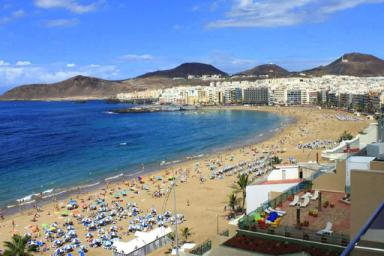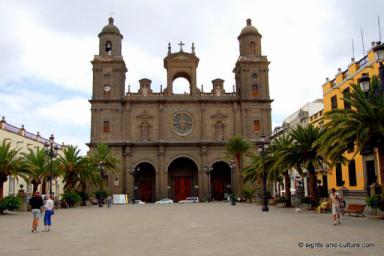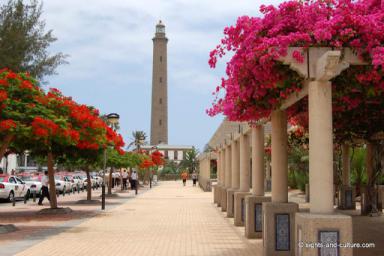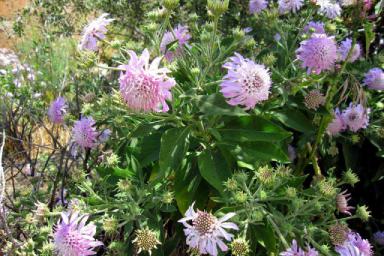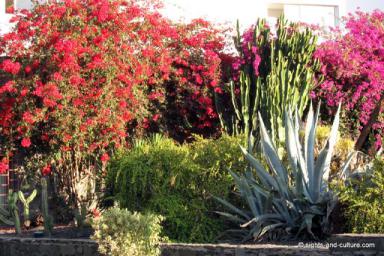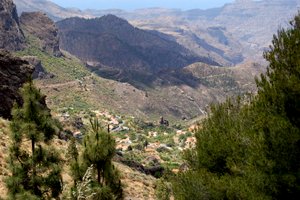
The circular, rocky island of volcanic origin has a diameter of just 50 km, but due to its different climates and its great variety of landscapes, it has an amazing range of interesting cultural and natural sites, which gave it the epithet “continent en miniature”
With a height of 1949 m. the Pico de las Nieves towers majestically above the Cumbres, the central mountainous region of the island, and offers spectacular views of the surroundings as far as Tenerife! The landmark of Gran Canaria is, however, the nearby
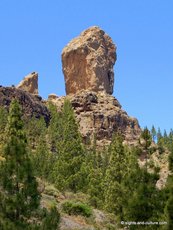 mystic Roque Nublo (1813 m) which carries an 80 m tall monolith made from basalt in the shape of a finger. Around the rock a beautiful flora can be found.
mystic Roque Nublo (1813 m) which carries an 80 m tall monolith made from basalt in the shape of a finger. Around the rock a beautiful flora can be found.The bizarre shaped rock- and mountain ranges in the centre, up to nearly 2000 m in height, divide the island into the dry sunny south with dreamlike beaches and the wet, fertile north with wooded mountains as well as valleys and plains with luxurious subtropical vegetation and rich fauna and flora. This is why one third of the island is under protection as a Biosphere Reserve by UNESCO.
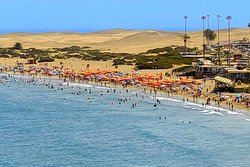 Most of the beach hotels are in the sunny south where the most beautiful beaches and the famous dunes of Maspalomas with the adjoyning, beautiful Playa del Ingles can be found. It’s true the area is very dry, but thanks to large-scale irrigation systems, one can enjoy rich, exotic subtropical vegetation at all tourist spots. With 10 golf courses the island is the perfect golfing destination all year long. We stayed at the Hotel Parque Tropical, which has a beautiful, romantique tropical garden.
Most of the beach hotels are in the sunny south where the most beautiful beaches and the famous dunes of Maspalomas with the adjoyning, beautiful Playa del Ingles can be found. It’s true the area is very dry, but thanks to large-scale irrigation systems, one can enjoy rich, exotic subtropical vegetation at all tourist spots. With 10 golf courses the island is the perfect golfing destination all year long. We stayed at the Hotel Parque Tropical, which has a beautiful, romantique tropical garden. A drive across the island in south-north direction is an interesting and exciting experience and a "must". The roads wind through the mountains in oodles of serpentines with breathtaking acute bends, ascents and descents that make the tour adventurous. Along the way there are great vantage points and lovely small old villages and towns, like the former place of pilgrimage, Teror. The tour may finish in the north at Arucas, the city with the dark church built from lava rocks and the highest steeple of the Canaries (60m). 12 km away from the city the vantage point “Montana de Arucas” (412m) offers great views of the coastline and the island.
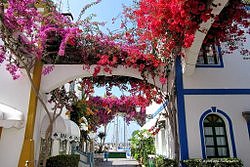 Also the charming city
Puerto de Mogan
(slide show) on the south-western coast is well worth a trip. The lovely, small marina has a fine golden beach and is decorated with an abundance of flowers. Arches with luxurious flowering bougainvillea span the small alleys and offer enchanting views against the background of the small, white houses and the blue sky. Many beautiful yachts lie at anchor in the harbour.
Also the charming city
Puerto de Mogan
(slide show) on the south-western coast is well worth a trip. The lovely, small marina has a fine golden beach and is decorated with an abundance of flowers. Arches with luxurious flowering bougainvillea span the small alleys and offer enchanting views against the background of the small, white houses and the blue sky. Many beautiful yachts lie at anchor in the harbour.When we took the ferry from Puerto Mogan to Puerto Rico we were lucky enough to watch dolphins! They really put on a show for us – came up and dived into the water in varying formations! We thought they may not like our noisy ship, but possibly they get food from the crew every now and then ...
In general there are very good bus connections all over the island for all places of interest.
| © 2000-2025 sights-and-culture.com | contact | feeback | disclaimer |



